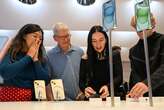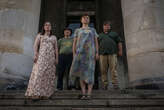A new social media app has captivated Gen Z—not by introducing something revolutionary, but by tapping into something familiar. Founder and CEO of Noplace Tiffany Zhong shares why bringing back the old-school charm of Myspace and early Facebook is proving that the past holds the key to the future of connection.
This is an abridged transcript of an interview from Rapid Response, hosted by the former editor-in-chief of Fast Company Bob Safian. From the team behind the Masters of Scale podcast, Rapid Response features candid conversations with today’s top business leaders navigating real-time challenges. Subscribe to Rapid Response wherever you get your podcasts to ensure you never miss an episode.
So Noplace launched publicly this summer, a new social media in a very crowded space. And yet, it quickly jumped to the top of the app store. A lot of downloads, particularly among young people. For those who haven’t seen it, what is Noplace? What’s different about it?
So Noplace is . . . Really how we describe it is like the most social network. When you look at the last 10 years, the pendulum has completely swung towards social media just being media these days. There’s nothing really social about it anymore. You don’t know what your friends are up to anymore. All of it has been taken over by content and media. I realized that there was a huge opportunity to, and a problem to be solved, around giving Gen Zs and Gen Alpha a place where they can actually be social again. In middle school, I grew up on Facebook and Tumblr. And that’s really shaped how I think about product and consumer behavior even today.
And Noplace is text based. I mean, there’s no photos or videos, which is kind of counter to the trend.
It was a very intentional product decision to only do text at first. That doesn’t mean we won’t do photos or videos down the line. But the reasoning behind that was basically, we want people to actually post what they’re thinking. That kind of constraint of only allowing text brings a different kind of creativity and different kinds of posts when it comes to this generation that has never been on a social platform that has been only text.
Clearly this is resonating. You built up a waitlist of like 500,000 users before you even launched publicly. But a lot of that was through viral TikTok videos, which is, it’s kind of ironic, isn’t it that you don’t do video, but video is sort of what engaged people about the idea of the site?
Yeah, you have to go where the teens are, right? And so if they’re spending the time on TikTok and Instagram and Twitter, that’s where we validate the idea early on. It actually, at the end of last year, went viral on Twitter. Even when we were still invite-only and still had a waitlist. And still it managed to go viral and was top of the charts—especially in the social networking category. And keep in mind, like most people who downloaded the app couldn’t get access because you needed an invite code to join. And so it was pretty crazy to see that happen.
And it especially resonated with the K-pop and Anime, Manga community on Twitter because of how customizable your profiles are with the colors, being able to share what you’re currently listening to, reading, watching, gaming, your mood, your IRL . . . And so you’ll see our users being like their IRL, their current location is like school and where they’re going next is the library or Starbucks. It’s really interesting to see that, given Gen Z is a place where they can be their most creative selves and see what comes out of that. There’s no one profile that is like another profile as a result.
A lot of people want their ideas to go viral. Is there something specific that you did that helped that happen or was it just organic?
It was just organic on Twitter. Especially for a generation that was not on Myspace and had never had a place where they could customize however they wanted. Like I was too young for Myspace, which is kind of ironic that we’re rebuilding a lot of the different early social networks in one.
I will say I downloaded the app and it felt pretty quick right away that it wasn’t really for me, for someone my age. That’s right, isn’t it? I mean, like a lot of the folks were a lot younger . . . Younger than you.
So we have a lot of users from middle school, high school, college, recent grads. It definitely skews younger, because this is what they’re drawn to. We’re going back to the fact that they’ve never had an app like this before. They don’t have a place that they consider social media these days. So, bridging the gap between self-expression and connection is really what keeps people coming back.
I noticed there aren’t any ads on Noplace right now and it’s free to use. So there’s no monetization plan. At least not yet, I can see right now. I imagine there is.
Yeah, we’re thinking through a bunch of different revenue streams. Consumer social is undoubtedly one of the hardest spaces to build in because a lot of it is art. Art more than science. There’s no specific playbook like there might be in B2B SaaS. You have to ship things fast, iterate, listen to your users, see how they’re behaving, how they’re using the app, and also have a balance between looking at the data and trusting your intuition. But I think the biggest thing in building consumer products is persistence, being patient with the process.
You founded another company called Zebra Intelligence to help brands reach a Gen Z audience. What do business leaders today most misunderstand about Gen Z?
Gen Zs really care about authenticity, both brands that they shop from, but also a place where they can be their real authentic self. After years of being on platforms where edited, curated, kind of photos of yourself—we’ve seen that play out and now we’re completely shifting to the other direction of “I just want a place where I can share whatever’s on my mind with close friends. I’m not trying to hyperedit every single photo anymore.” Or at least I don’t want to. That’s why this has resonated so much with Gen Zs. Gen Zs want that feeling of not trying to make everything perfect.
You’ve said that Gen Z sort of see through the BS. For you personally, does that make you kind of more at ease to be yourself as a leader or sort of more self-conscious of what you say and do, because they’re going to see through my BS? Do you have any advice for other business leaders about how they should conduct themselves?
Leaning into your personality. For me, for example, I try to be extremely real with our users. I will jump into random posts and comment and just be myself. And I think our users really appreciate that. That doesn’t necessarily mean I resonate a hundred percent with a hundred percent of our users. I have my own personality and my own values and Gen Zs care more about seeing that than seeing a perfect caricature that’s designed to sell to them. They can see through that.
How much have you thought about when Generation Alpha turns 18 and kind of culture shifts again? Like, do you feel particularly suited to Gen Z trends as a Gen Z yourself, or will things shift again when Gen Alpha starts to rise?
Everything happens in cycles. If you look at 15, 20 years ago, like what’s old is new again: Y2K, vintage film cameras, all of that. That’s cool again. And so we will see that happen with every generation as well. I think of Gen Z as a generation that grew up on smartphones and Gen Alpha probably more so on tablets. The generation after that, maybe that’s AI? People don’t change that much in terms of consumer behavior and consumer psychology. We all still care about human connection. That’s never going to go away.









No comments